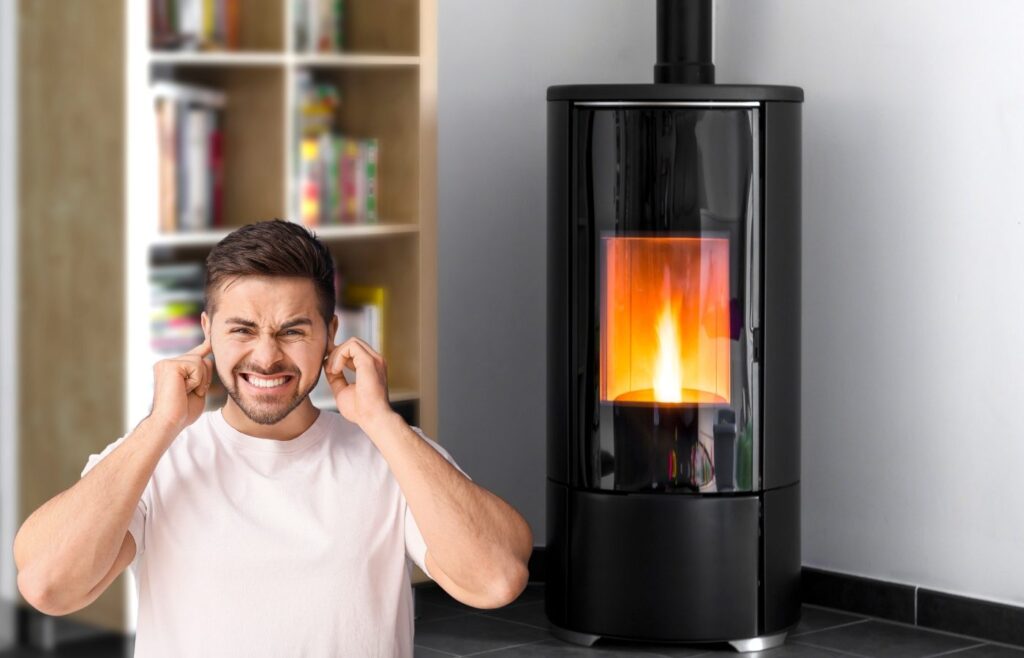The pellet stove is an economical and eco-friendly heating solution favored by many households. However, when unusual noises start to occur, thermal comfort can quickly turn into a source of noise disturbances. Let’s explore the possible causes and solutions to restore the tranquility of your home.
Why Is Your Pellet Stove Fan Making Noise?
Noise disturbances from a pellet stove can stem from various sources. The primary source of noise usually comes from the ventilation system, which consists of different mechanisms in constant motion. Normal operation generates a slight hum, but more pronounced noises often indicate a malfunction.
The ventilation system is responsible for circulating warm air in your room and expelling smoke. When abnormal noises occur, they often result from a buildup of debris, mechanical imbalance, or wear of components.
Quickly identifying these anomalies can prevent more significant damage to your appliance.
1. Check If a Pellet Has Fallen Into the Fan
A misplaced pellet in the fan mechanism can cause unpleasant clicking noises. This situation sometimes occurs during filling the hopper or as a result of poor combustion. Visually inspecting the fan requires partial disassembly of the appliance, a task to be performed after the stove has completely cooled.
To remove a stuck pellet, use appropriate tools such as fine tweezers or a special ash vacuum. This intervention requires delicacy to avoid damaging the fan blades. Once the foreign object is removed, check the free rotation of the fan before putting your stove back into service.
2. Clean Regularly the Ash and Dust
The accumulation of ash and dust is a major cause of noise disturbances. These residues create deposits that disrupt the optimal functioning of the fans. Weekly cleaning of the combustion chamber and accessible surfaces effectively prevents these inconveniences.
Maintenance includes the use of a special ash vacuum in accessible ducts and wiping the fan blades with a dry cloth. This simple maintenance routine extends the life of your appliance while maintaining its original acoustic performance.
3. Check the Condition of the Fan Motor
The fan motor naturally experiences wear over time. Defective bearings or insufficient lubrication produce vibrations and characteristic noises. Regular inspection of the motor allows early detection of these signs of mechanical fatigue.
The motor check starts with observing its operation at different speeds. Metallic noises or excessive vibrations often indicate a mechanical problem that requires the intervention of a qualified professional to carry out repairs or replace worn parts.
4. Check the Alignment of the Fan Blades
Misalignment of the blades can cause abnormal vibrations and whistling noises. This situation may occur due to a shock, thermal deformation, or wear of the fixings. A visual inspection of the blades allows for quick detection of any alignment defects.
Realigning the blades requires specific technical skills. A professional has the tools and expertise necessary to correct such a problem. A precise intervention ensures the return to silent operation of your appliance.
Some Tips to Prevent Noise Problems
Prevention is the best strategy to keep your stove quiet. Using certified quality pellets reduces the formation of residues and protects the mechanisms. Ensuring professional installation initially also guarantees optimal and durable operation.
Establish a regular maintenance schedule that includes cleaning various components and checking operational parameters.
This preventive approach helps avoid many acoustic problems and maintain the efficiency of your heating system.
Have you ever encountered noise issues with your pellet stove? Share your experience in the comments! What solution did you find to resolve these noise disturbances? Perhaps you have a particular tip for keeping your fan silent? Your advice can help other users regain the acoustic comfort of their home.

